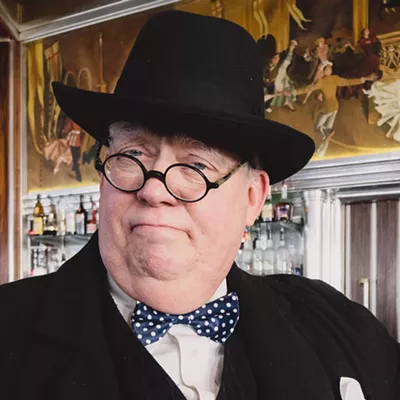Last Wishes
"A Living Will Is Not Enough"Presented by John Abraham, Executive Director of End of Life Choices-Arizona
1:30 to 3:30 p.m., Saturday, May 7
Epoch Assisted Living at Ventana Canyon, 5660 N. Kolb Road
577-6940, choicesarizona.org
Free; RSVP preferred
If you've watched ER a few times over the years, you've probably seen an episode or two where family members are faced with an agonizing decision: whether to operate, sustain life or otherwise. Often times, the injured family member has not left instructions for this situation.
Although it's a dramatized story on television, the occurrence is true to life. Terri Schiavo's death polarized the nation.
One thing that resulted from Schiavo's death was a realization that we all should document our wishes for the ends of our lives. According to John Abraham, executive director of End of Life Choices--Arizona, a living will is not enough. End of Life Choices is a nonprofit that educates its members and the general public about the choices available as one approaches the end of life.
Abraham's lecture will be held at Epoch Assisted Living, an assisted-living community that offers a full spectrum of medical and rehab services. Abraham "is giving people information about what their end of life choices are and what is critical that they need to know," says Epoch marketing director Sharon Roffman. She says Abraham will cite cases of siblings who have fought over and went against a person's wishes. To guard against that, an Advance Directive Package is recommended.
The Advance Directive Package "has all the information that you really need to supercede other people coming in to change what you requested," says Roffman. "It's a necessary thing. If you don't let people know what you want, they are going to do what they want." --I.M.
Chronicling Choo-Choos
Locomotive Saturdays10 a.m. to 1 p.m., Saturdays in May
The Southern Arizona Transportation Museum in The Historic Depot
414 N. Toole Ave.
623-2223
tucsonhistoricdepot.org
Free, $2 suggested donation
On at least three separate occasions, March 20 has been a historic day for Tucson. On March 20, 1880, the first train arrived in town with much fanfare. According to Weekly writer Dave Devine, more than 1,200 people gathered at the future site of Tucson's depot to witness the event.
On March 20, 1882, Doc Holliday and Wyatt Earp were passing through Tucson on their way to bury Wyatt's brother, Morgan, in California. Historical accounts indicate Frank Stillwell shot Morgan. According to Southern Arizona Transportation Museum director Laura Caywood Barker, Stillwell was spotted around the depot and was killed by Wyatt Earp to avenge his brother's death.
Finally, on March 20, 2005, the Southern Arizona Transportation Museum opened in Tucson. Barker says the museum is self-guided and shows how Tucson changed after the railroad arrived. It's located at the Historic Depot, so visitors can also see and hear between 30 and 40 freight trains pass through daily. "For freight trains, it's the most (active) it's ever been in history," says Barker.
While the museum is open during the week for individuals, school tours and civic tours, on Saturdays, track gates open so that visitors may take an up-close look at Locomotive No. 1673. According to tucsonhistoricdepot.org, Locomotive No. 1673 is one of 105 of its type originally numbered 1615-1719 for the Southern Pacific Railroad. During operation on the Southern Pacific line, it logged more than 1 million miles, primarily in freight service in Southern Arizona. In December 2000, the engine was brought to Tucson. The engine is listed on the National Register of Historic Places. --I.M.
Boy, Do They Ever Happen!
Odyssey Story Telling Series7 p.m. (doors open at 6), Thursday, May 5
Wilde Playhouse, 135 E. Congress St.
www.odysseystorytelling.com, 730-4112
It's not fiction. It's not memorized. It's not read from a script. These are personal stories from people's lives. You'll hear from a doctor, a nurse, a grief counselor, a storyteller, a writer and an artist in this week's Odyssey Story Telling Series.
"It's an intimate space. There are tables, chairs and couches, so it's kind of like you're sitting in your living room and listening to somebody tell you these stories," says Penelope Starr, the series coordinator.
Although the show features a variety of tales, "there's a thread going through them," Starr says. They all follow this month's theme: "mistakes happen."
Since the series began more than a year ago, the Wilde Playhouse has seen a wide range of topics from comedy to tragedy. For March's theme, "anniversaries," one man told the story of how he had to trick his wife, who was an extreme workaholic, into celebrating their 20th wedding anniversary. He relayed the anecdote explaining how he had to go behind her back and collaborate with her co-workers to commemorate the day.
On a different occasion, a man told how he was attacked outside a gay club just one year prior, and how he was recovering from it.
"You can see the difference between the stories with something that's so tragic and poignant and one that's amusing and funny," Starr says.
During the intermission, a volunteer from the audience will tell a three-minute story. Starr has had nearly 100 storytellers perform for audiences of all ages since she started.
"It's people who have different life experiences. Its fun." Starr recommends getting there early, because typically by the start of the show, it's a packed house.
Admission is $7. --A.L.
Everything Including the Kitchen Sink
Touching The Surface Art ShowOpening Reception 5-7 P.m. Friday, May 6
UA Student Union, Kachina Gallery, below Second Street at Mountain Avenue
227-6108
Andi Allen, a UA studio art senior, likes to take ordinary objects and make them into art. Aluminum foil, palm fronds and a sink basin are among the items she has used to create her first solo art exhibit, Touching the Surface. It's a combination of three-dimensional work such as sculptures and weaving, and two-dimensional work such as photography, collages and drawings.
"Being in an intellectual atmosphere, it's a little tedious. You're forced to use all these media, like painting, that are more common. So I thought I would take a different approach to making art work," Allen says.
Her favorite piece is "Packaging," a depiction of hairstyles throughout history made entirely of pink plastic foam peanuts. Allen glued the peanuts, which she considers wasteful and toxic to the environment, together and put them on 11 plastic foam heads.
"I thought it would be interesting to take a material that is not expensive and is something you see everyday and (show it) in an aesthetically pleasing way," Allen said.
Another favorite piece, which Allen says shows the development of her artistic eye, is a "simple piece of wood" she found a few years ago that she coiled with multicolored yarn. She named it "Victory" and said it's the only piece of the collection not for sale. She's giving it to her father instead.
Allen says the show is her "final hoorah" before she graduates next week.
Gallery hours are 6:30 a.m. to 11 p.m. Monday through Friday, and 8 a.m. to 11 p.m. Saturday and Sunday. The exhibit closes June 1. --A.L.







